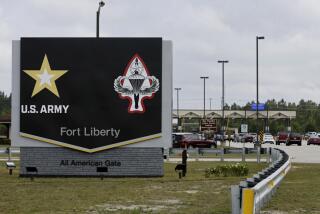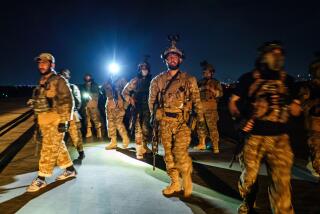Signs of Settling In at U.S. Camp
- Share via
BAGRAM AIR BASE, Afghanistan — As American troops marked Memorial Day with a barbecue here Sunday, they were surrounded by mounting evidence that U.S. forces will probably be at this base for Memorial Days to come.
Across the dusty compound north of Kabul, the Afghan capital, are signs that the United States is settling in. The dilapidated Soviet-built structures that dominate the landscape have received new roofs in recent weeks. Afghan crews are installing new windows and sealing up the pockmarks of war with thick layers of fresh mortar.
Trucks line up outside the base’s main gate every morning, loaded with gravel and building materials. And within weeks, a permanent power generation facility is scheduled to start up, ending the base’s reliance on dozens of portable generators.
Perhaps most telling of all, new rules are kicking in requiring soldiers here to salute their superiors. The policy is widely viewed by the rank and file as a nuisance, but officers said the change reflects Bagram’s transition from no-nonsense combat zone to a more traditionally ritualized military installation.
The changes underscore a growing realization at Bagram, which is home to about 3,000 U.S. troops, that even if the military objectives are easy to spell out, predicting how long it will take to achieve them is not.
The first priority remains rooting out Osama bin Laden’s terrorist network, and coalition forces continue to have success. Last week, a raid near Kandahar, in the south, netted about 50 suspected Al Qaeda or Taliban members.
But progress on this front appears increasingly incremental. Officials said Sunday that it’s almost inevitable that some, if not many, of those captured last week will turn out to have no terrorist connection and be released.
Military leaders acknowledge that large-scale battles such as Operation Anaconda in March are increasingly unlikely. Instead, most expect infrequent encounters with small pockets of the enemy along the Pakistani border.
“I’d be surprised if the enemy coalesced again like he did at Anaconda,” said Lt. Col. David Gray, the chief of military operations at Bagram. Americans should see the new direction of the war as evidence of its overall success, he said.
“We’ve hurt Bin Laden bad and got him on the run,” Gray said.
The question now is how to keep him that way without requiring U.S. troops to permanently patrol the Afghan-Pakistani border. U.S. leaders say that eventually that task will fall to the nascent Afghan army. American Special Forces soldiers recently began training its first 500 members, and the Pentagon has said the goal is for Afghanistan to field an army of about 18,000 troops.
“That’s a long-term process,” Gray said.
For clues to how quickly Afghanistan might be able to manage its own affairs, U.S. officials are closely eyeing the loya jirga, the complicated nationwide assembly that will be held next month. U.S. officials are anxious to see whether there will be an orderly transition from the interim government of Prime Minister Hamid Karzai to a more permanent structure.
“If people in Afghanistan see that as a legitimate process, it will bode well for the country and our mission,” said Maj. Bryan Hilferty, spokesman for coalition forces at Bagram.
Sensitive to the question of how long the U.S. might be here, Hilferty and others are quick to point out that the changes underway are not too permanent. Construction is being done to comply with Afghan standards, not U.S. code.
Hilferty noted that a new technical operations center was built of cheap plywood. “That doesn’t exactly reek of a 40-year plan,” he said. “This is an Afghan air force base; we’re merely their guests.”
Even so, Hilferty said, “We’re going to be here for a few more holidays. That’s certainly true.”
More to Read
Sign up for Essential California
The most important California stories and recommendations in your inbox every morning.
You may occasionally receive promotional content from the Los Angeles Times.













